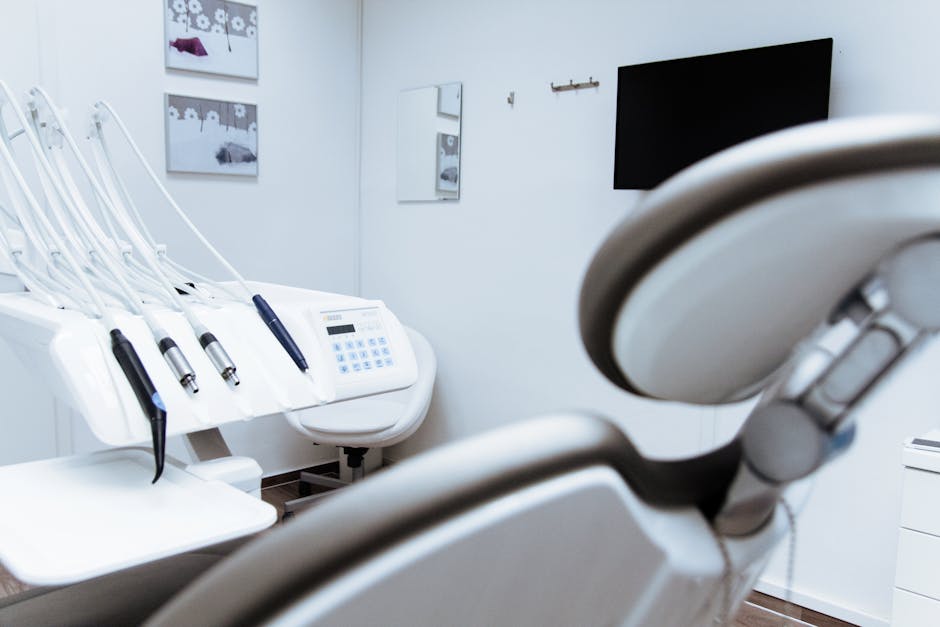How to Set Up Your Medical Office Network Without Losing Your Mind
July 4, 2025

Unlock growth with smart IT solutions for small business. Boost productivity, secure data, and optimize costs with expert guidance.
January 1, 2026

Boost your practice with 7 amazing Healthcare Management IT Services. Secure data, improve efficiency & ensure compliance. Discover your IT partner today!
December 31, 2025

Discover the ins and outs of remote access solutions. Enhance productivity, fortify security, and empower your remote workforce.
December 30, 2025
July 4, 2025
Setting up a medical office network setup can feel overwhelming, but breaking it down into manageable steps makes all the difference. Here's what you need to know:
Essential Components for Medical Office Networks:
Key Planning Steps:
As one medical practice owner shared: "Your newly established or recently relocated medical office provides patients with critical healthcare services—and without a strong, high-quality network provider, you are putting your practice, your staff, and your patients at risk."
The reality is stark: Network downtime in healthcare isn't just inconvenient—it can block access to patient records, disrupt care delivery, and create compliance headaches. Achieving "five nines" reliability (99.999% uptime) should be your target, which means less than 5 minutes of downtime per year.
Modern medical offices face unique challenges that general business networks don't. You're juggling electronic health records, imaging systems, VoIP phones, and telemedicine platforms. Add HIPAA compliance requirements, and suddenly your network setup becomes mission-critical infrastructure.
I'm Steve Payerle, President of Next Level Technologies, and I've spent over 15 years helping medical practices build secure, compliant networks that actually work. Our extensively trained cybersecurity specialists have guided countless medical office network setup projects across Ohio and West Virginia, turning complex technical requirements into reliable, HIPAA-compliant solutions.

Basic medical office network setup terms:

The most expensive medical office network setup isn't the one with premium equipment—it's the one that wasn't planned properly. After 15 years in the business, I've learned that proper planning prevents costly mistakes.
Your needs assessment is everything. Start by walking through your office with a notepad. Count every device that needs internet access—computers, tablets, printers, digital X-ray machines, credit card readers, even smart thermostats. Our extensively trained cybersecurity specialists typically find that practices underestimate their device count by 40-50%.
Workflow mapping means watching how your team works. Where does your nurse practitioner access patient records? Which exam rooms need wireless coverage? Understanding these patterns helps place access points and network drops where they'll actually be useful.
Bandwidth forecasting requires thinking beyond today's needs. Medical offices typically expand their connected devices by 30-50% within two years. Plan accordingly.
For practices in Columbus, Ohio and Charleston, West Virginia, local regulations can add timeline delays. Building codes vary between jurisdictions, and permit requirements can stretch projects by 2-3 weeks. Our team knows these local requirements inside and out.
Five-nines reliability (99.999% uptime) requires redundant internet connections, UPS systems, and backup power solutions. Your network is only as reliable as its weakest link.

Capacity planning starts with honest math. Count current users, then multiply by 1.5 for growth. Consider bandwidth needs for EHR systems (1-2 Mbps per user), video conferencing (3-5 Mbps per session), and cloud backups.
IP addressing scheme should be logical with room for growth. We recommend segmenting networks into distinct ranges: clinical workstations (192.168.1.0/24), administrative systems (192.168.2.0/24), guest access (192.168.3.0/24), and medical devices (192.168.4.0/24).
VLAN design provides HIPAA-required security separation. Create separate VLANs for clinical data, administrative functions, guest access, and medical devices.
Redundancy goals should include dual internet connections, UPS systems with 30+ minutes runtime, backup network equipment, and automated failover systems.
For detailed guidance, check out our guide on IT Services for Medical Offices.
Phase 1 (Weeks 1-2): Infrastructure Planning - site surveys, workflow analysis, network design, equipment specification, permit applications.
Phase 2 (Weeks 3-4): Physical Installation - cabling installation, equipment mounting, power systems.
Phase 3 (Weeks 5-6): Configuration and Testing - device configuration, security implementation, performance testing.
Phase 4 (Week 7): Go-Live and Training - final testing, staff training, documentation, monitoring setup.
Go-live testing should include stress testing with multiple users, failover testing, and security validation. Better to find problems now than during patient care.
Selecting the right hardware for your medical office network setup requires focusing on what actually matters for healthcare operations.
Enterprise-grade routers with built-in security features, VPN capabilities, and Quality of Service controls are essential. Skip consumer equipment—medical offices need routers that can prioritize critical traffic like EHR access.
Managed switches provide the intelligence your network needs. Unlike basic switches, managed switches let you configure VLANs, monitor traffic, and quickly identify problems. Our extensively trained cybersecurity specialists typically recommend 24-port switches for growing practices.
Dedicated firewalls are non-negotiable in healthcare. With 58% of healthcare breach victims attacked through known vulnerabilities, firewalls with intrusion detection and prevention are essential for HIPAA compliance.
Server decisions depend on EHR requirements and practice size. Many practices accept cloud solutions but still need local servers for file sharing, print services, and backup storage.
Wi-Fi 6 access points handle high-device environments better and provide improved security with WPA3 encryption. Plan for one access point per 1,500-2,000 square feet.
Cabling choices:
| Connection Type | Speed | Distance | Cost | Best For |
|---|---|---|---|---|
| Cat6 Ethernet | 1 Gbps | 100m max | $0.20-$1/ft | Workstations, printers |
| Cat6A Ethernet | 10 Gbps | 100m max | $0.50-$1.50/ft | Server connections |
| Fiber Optic | 10+ Gbps | 2000m+ | $1-$3/ft | Building-to-building |
UPS systems keep critical systems running during power outages. Size your UPS to support servers, network equipment, and at least one workstation for 30+ minutes.
Symmetrical fiber connections provide equal upload and download speeds, crucial for cloud-based EHR systems and telemedicine. Cable internet's limited upload bandwidth creates bottlenecks.
4G/LTE failover automatically activates when primary internet fails, ensuring continuous access to cloud systems.
Throughput requirements: Basic EHR usage needs 25-50 Mbps per user, digital imaging requires 100+ Mbps, telemedicine needs 1-2 Mbps per call, and cloud backups should have 10-20 Mbps dedicated bandwidth.
SLA review should guarantee 99.9%+ uptime with clearly defined response times and escalation procedures.
Cable run limitations: Ethernet cables have a 100-meter maximum. Beyond this, you'll experience signal degradation.
Labeling systems save hours during troubleshooting. Label both ends of every cable with room number, jack number, and destination.
Dual drops per workstation provide redundancy—run two cables to each location for computers and VoIP phones.
For EHR-specific considerations, see our guide on Electronic Health Record Support.
Patient data is worth 10-40 times more than credit card information on the dark web, making your medical office network setup a prime target for cybercriminals.
HIPAA compliance requires encryption of data in transit and at rest, robust access controls, comprehensive audit logging, and secure backup procedures. Our extensively trained cybersecurity specialists help practices across Columbus, Ohio and Charleston, West Virginia steer these requirements successfully.
Multi-factor authentication (MFA) adds crucial security layers. Even with stolen passwords, MFA stops attackers. Enable MFA for all users, not just administrators.
Endpoint Detection and Response (EDR) goes beyond traditional antivirus, watching system behavior to catch advanced threats that signature-based detection misses.
Log monitoring and audit trails are HIPAA requirements. Your network must track all access attempts, failed logins, and data access events with secure storage and regular review.
Staff training addresses the human element—95% of successful cyber attacks happen due to human error. Regular training on phishing recognition and password security is essential.
For comprehensive guidance, visit Office Network Security – Cybersecurity for the Office Network.
Network segmentation isolates different traffic types and prevents unauthorized access.
SSID configuration should create separate networks: clinical staff (WPA3-Enterprise), administrative (WPA3-Enterprise), guest (WPA3-Personal with captive portal), and IoT/medical devices (isolated VLAN).
VLAN implementation provides logical separation. Clinical workstations can't communicate directly with guest devices—like invisible walls keeping sensitive data separate.
Quality of Service (QoS) prioritizes critical traffic. VoIP calls and EHR access get priority over guest internet browsing.
WPA3 encryption offers significant security improvements over WPA2, including protection against offline dictionary attacks.
The 3-2-1 backup strategy remains the gold standard: three copies of data, on two different media types, with one copy offsite.
Cloud replication provides automatic, secure backup with HIPAA-compliant providers who sign Business Associate Agreements.
UPS testing should happen monthly—battery systems degrade over time, and finding failures during actual outages is too late.
Patch management keeps systems secure through timely security updates. Balance security with system stability through automated systems with manual approval for critical patches.
Regular maintenance includes monthly backup verification, quarterly security assessments, annual hardware inspections, and ongoing staff training.
For comprehensive planning, review our guide on Data Backup and Recovery.

Your medical office network setup must prepare for tomorrow's opportunities. Healthcare technology evolves rapidly, and forward-thinking practices will thrive.
Telemedicine has transformed from nice-to-have into essential service. Quality video consultations require minimum 2 Mbps dedicated bandwidth per session, with proper Quality of Service configuration prioritizing this traffic.
Internet of Medical Things (IoMT) devices improve patient care but create security vulnerabilities. Our extensively trained cybersecurity specialists develop IoMT segmentation protocols—keeping medical devices on isolated network segments.
Wi-Fi 6E technology opens the 6 GHz frequency band, providing more channels and less congestion. This is valuable in medical environments with multiple competing devices.
Zero-trust network architecture assumes every connection needs verification rather than trusting devices inside your network perimeter. This approach is becoming essential as practices adopt more cloud services.
Capacity headroom planning means designing networks to handle 2-3 times current requirements, preventing performance degradation when networks reach capacity limits.

Initial investment for comprehensive medical office network setup typically ranges from $1,000 to $5,000 for small practices, with larger installations reaching $10,000+.
Hardware refresh cycles should be planned every 3-5 years for network equipment and 3-4 years for computers. This prevents security vulnerabilities and performance bottlenecks while spreading costs over time.
Maintenance contracts provide ongoing support and hardware replacement coverage. Annual fees typically range from $500 to $2,000, depending on complexity.
Total Cost of Ownership (TCO) includes installation, maintenance, training, and potential downtime costs. Compare against Return on Investment (ROI) from improved efficiency and patient care.
Grant and tax incentives may be available. USDA offers grants for rural healthcare facilities, and various state programs provide technology funding.
Energy efficiency considerations reduce operational costs. Modern equipment uses less power, and proper UPS sizing prevents waste.
A small medical practice needs minimum 25 Mbps download and 10 Mbps upload for basic operations, but our extensively trained cybersecurity specialists recommend 100 Mbps symmetrical fiber for optimal performance.
Your EHR system requires 5-10 Mbps per person accessing records simultaneously. With 4-6 staff members, you need 20-60 Mbps just for basic record access.
Cloud backups consume 10-20 Mbps during backup windows, competing with patient care activities if running during business hours.
Telemedicine sessions add 1-2 Mbps per video consultation. Multiple concurrent appointments quickly overwhelm under-provisioned connections.
Digital imaging systems require substantial bandwidth for uploading X-rays, MRIs, and large files to cloud storage.
Our team has learned from medical office network setup projects across Columbus, Ohio and Charleston, West Virginia: symmetrical fiber connections are worth the investment. Upload speed matters as much as download speed for cloud-based EHR systems, automated backups, and telemedicine.
Network isolation makes it possible to offer guest Wi-Fi without compromising patient data security. Your guest network should be entirely isolated from clinical systems through VLANs and firewall rules.
Implementation steps: Create separate SSID for guest access, configure dedicated VLAN for guest traffic, block all communication between guest and clinical networks, implement bandwidth limits, and use captive portal for terms of service.
Monitoring and logging help identify security issues and provide audit trails. Set up automatic session timeouts so guest access doesn't remain active indefinitely.
With proper medical office network setup, you can safely offer guest Wi-Fi without putting patient data at risk.
For most medical practices, outsourcing IT provides better value and expertise than hiring in-house staff. Healthcare's specialized compliance and security requirements make this particularly true.
Outsourcing advantages: Access to extensively trained cybersecurity specialists who understand HIPAA requirements, 24/7 monitoring and support, predictable monthly costs, and compliance expertise without employee overhead.
The breakeven point typically occurs around 25-30 employees. Smaller practices benefit significantly from outsourced IT, while larger practices may justify in-house staff.
Our team in Columbus, Ohio and Charleston, West Virginia has found that medical practices benefit most from outsourced IT due to healthcare technology's specialized nature. The compliance requirements alone make expert knowledge valuable.
Building a successful medical office network setup might seem daunting at first, but with the right roadmap and expert guidance, it becomes a manageable project that sets your practice up for long-term success. Throughout this guide, we've walked through every critical step—from that initial workflow analysis to implementing robust cybersecurity measures that keep your patient data safe.
Your network is the backbone of modern healthcare delivery. When patients arrive at your office, they expect seamless access to their records, efficient check-in processes, and the ability to communicate with specialists through telemedicine. None of this happens without a rock-solid network foundation.
The reality is that medical office network setup projects fail when practices try to cut corners or treat their network like a typical business installation. Healthcare has unique requirements that demand specialized expertise. HIPAA compliance isn't optional, network downtime can literally impact patient care, and cybersecurity threats specifically target medical practices because patient data is so valuable.
We've seen the consequences of inadequate planning. Practices that rush into equipment purchases without proper workflow analysis end up with dead zones where staff can't access patient records. Others find their internet connection can't handle their EHR system during busy periods. Some face devastating security breaches because they didn't implement proper network segmentation.
Next Level Technologies has spent over 15 years helping medical practices avoid these pitfalls. Our extensively trained cybersecurity specialists understand that your network needs to work perfectly from day one. We've guided countless practices through successful medical office network setup projects across Columbus, Ohio and Charleston, West Virginia, turning complex technical requirements into reliable, compliant solutions.
Our approach is different because we focus on your specific needs. We start with detailed workflow analysis to understand how your staff actually works. We design networks that scale with your practice's growth. We implement security measures that protect patient data without getting in the way of efficient care delivery. And we provide ongoing support so you never have to worry about network problems disrupting your practice.
The investment in proper network setup pays dividends every day. When your EHR system loads quickly, staff can see more patients. When your telemedicine platform works flawlessly, you can expand your service offerings. When your backup systems work automatically, you sleep better knowing patient data is protected.
Don't let network problems hold your practice back. The cost of downtime, security breaches, or compliance violations far exceeds the investment in doing things right from the start. Your patients deserve better than frozen computers and dropped video calls during consultations.
Ready to build a network that actually supports your practice's mission? Contact Next Level Technologies today for a free consultation. Our team will assess your specific workflow needs and create a customized plan that ensures reliable, secure, and compliant network operations. We'll handle the technical complexity so you can focus on what you do best—caring for patients.
Let us turn this comprehensive checklist into a compliant, rock-solid reality for your practice. With our proactive support and extensive cybersecurity training, you'll have the peace of mind that comes from knowing your network infrastructure is built to last.
For more information about our specialized healthcare IT services, visit our guide on Managed IT Services for Medical Practices.
Unlock growth with smart IT solutions for small business. Boost productivity, secure data, and optimize costs with expert guidance.
January 1, 2026
Boost your practice with 7 amazing Healthcare Management IT Services. Secure data, improve efficiency & ensure compliance. Discover your IT partner today!
December 31, 2025
Next Level Technologies was founded to provide a better alternative to traditional computer repair and ‘break/fix’ services. Headquartered in Columbus, Ohio since 2009, the company has been helping it’s clients transform their organizations through smart, efficient, and surprisingly cost-effective IT solutions.
